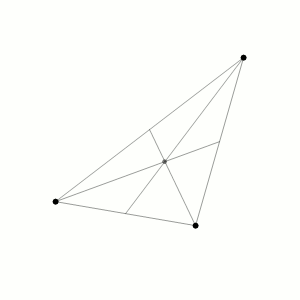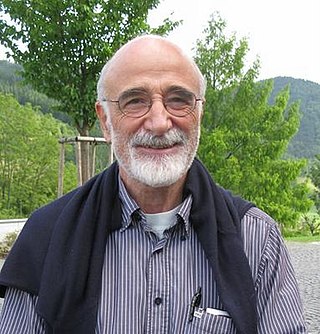Related Research Articles
The following outline is provided as an overview of and topical guide to physics:

In physics, gravity (from Latin gravitas 'weight') is a fundamental interaction primarily observed as mutual attraction between all things that have mass. Gravity is, by far, the weakest of the four fundamental interactions, approximately 1038 times weaker than the strong interaction, 1036 times weaker than the electromagnetic force and 1029 times weaker than the weak interaction. As a result, it has no significant influence at the level of subatomic particles. However, gravity is the most significant interaction between objects at the macroscopic scale, and it determines the motion of planets, stars, galaxies, and even light.

Édouard Albert Roche was a French astronomer and mathematician, who is best known for his work in the field of celestial mechanics. His name was given to the concepts of the Roche sphere, Roche limit, and Roche lobe. He also was the author of works in meteorology.

Jules Henri Poincaré was a French mathematician, theoretical physicist, engineer, and philosopher of science. He is often described as a polymath, and in mathematics as "The Last Universalist", since he excelled in all fields of the discipline as it existed during his lifetime. Due to his scientific success, influence and his discoveries, he has been deemed "the philosopher par excellence of modern science."
Celestial mechanics is the branch of astronomy that deals with the motions of objects in outer space. Historically, celestial mechanics applies principles of physics to astronomical objects, such as stars and planets, to produce ephemeris data.

George William Hill was an American astronomer and mathematician. Working independently and largely in isolation from the wider scientific community, he made major contributions to celestial mechanics and to the theory of ordinary differential equations. The importance of his work was explicitly acknowledged by Henri Poincaré in 1905. In 1909 Hill was awarded the Royal Society's Copley Medal, "on the ground of his researches in mathematical astronomy". Hill is remembered for the Hill differential equation, along with the Hill sphere.

Forest Ray Moulton was an American astronomer. He was the brother of Harold G. Moulton, a noted economist.

In physics, specifically classical mechanics, the three-body problem involves taking the initial positions and velocities of three point masses that orbit each other in space and calculating their subsequent trajectories using Newton's laws of motion and Newton's law of universal gravitation.
Positional voting is a ranked voting electoral system in which the options or candidates receive points based on their rank position on each ballot and the one with the most points overall wins. The lower-ranked preference in any adjacent pair is generally of less value than the higher-ranked one. Although it may sometimes be weighted the same, it is never worth more. A valid progression of points or weightings may be chosen at will or it may form a mathematical sequence such as an arithmetic progression, a geometric one or a harmonic one. The set of weightings employed in an election heavily influences the rank ordering of the candidates. The steeper the initial decline in preference values with descending rank, the more polarised and less consensual the positional voting system becomes.

Eric Stark Maskin is an American economist and mathematician. He was jointly awarded the 2007 Nobel Memorial Prize in Economic Sciences with Leonid Hurwicz and Roger Myerson "for having laid the foundations of mechanism design theory". He is the Adams University Professor and Professor of Economics and Mathematics at Harvard University.

The School of Social Sciences is an academic unit of the University of California, Irvine (UCI) that studies the social sciences. The School is the largest academic unit in the university with an enrollment of over 5,300 students. More than a third of the bachelor's degrees conferred at UCI are from the School of Social Sciences. It is home to the departments of Anthropology, Chicano-Latino Studies, Cognitive Science, Economics, Logic and Philosophy of Science, Political Science, International Studies, and Sociology.
The Borda method or order of merit is a positional voting rule which gives each candidate a number of points equal to the number of candidates ranked below them: the lowest-ranked candidate gets 0 points, the second-lowest gets 1 point, and so on. Once all votes have been counted, the option or candidate with the most points is the winner.
Florin Nicolae Diacu was a Romanian Canadian mathematician and author.
In physics, the n-body problem is the problem of predicting the individual motions of a group of celestial objects interacting with each other gravitationally. Solving this problem has been motivated by the desire to understand the motions of the Sun, Moon, planets, and visible stars. In the 20th century, understanding the dynamics of globular cluster star systems became an important n-body problem. The n-body problem in general relativity is considerably more difficult to solve due to additional factors like time and space distortions.
Harry Pollard was an American mathematician. He received his Ph.D from Harvard University in 1942 under the supervision of David Widder. He then taught at Cornell University, and was Professor of Mathematics at Purdue University from 1961 until his death in 1985. He is known for his work on celestial mechanics, orthogonal polynomials and the n-body problem as well as for the several textbooks he authored or co-authored. In the theory of Orthogonal polynomials, Pollard solved a conjecture of Antoni Zygmund, establishing mean convergence of the partial sums in norms for the Legendre polynomials and Jacobi polynomials in a series of three papers in the Transactions of the American Mathematical Society. The first of these papers deals with the fundamental case of Legendre polynomials. The end point cases in Pollard's theorem was established by Sagun Chanillo.
Richard Paul McGehee is an American mathematician, who works on dynamical systems with special emphasis on celestial mechanics.

Alain Chenciner is a French mathematician, specializing in dynamical systems with applications to celestial mechanics.
Zhihong "Jeff" Xia is a Chinese-American mathematician.
In celestial mechanics, a central configuration is a system of point masses with the property that each mass is pulled by the combined gravitational force of the system directly towards the center of mass, with acceleration proportional to its distance from the center. Central configurations are studied in n-body problems formulated in Euclidean spaces of any dimension, although only dimensions one, two, and three are directly relevant for celestial mechanics in physical space.
Frederic Yui-Ming Wan is a Chinese-American applied mathematician, academic, author and consultant. He is a Professor Emeritus of Mathematics at the University of California, Irvine (UCI), and an Affiliate Professor of Applied Mathematics at the University of Washington (UW).
References
- ↑ One Person, One Vote May Not Be The Fairest Of Them All, National Public Radio, October 14, 1995.
Craven, Jo (November 1, 1998), "In Some Elections, The 'Bullet' Rules: Tactic Has Voters Skipping 2nd Choice", The Washington Post , archived from the original on April 24, 2017, retrieved April 23, 2017.
"Has there been any progress in developing fairer ways for people to vote in elections?", Questions and Answers, Scientific American , October 1999, archived from the original on 2010-06-30, retrieved 2017-04-23.
Mackenzie, Dana (November 1, 2000), "May The Best Man Lose", Discover Magazine .
Guterman, Lila (November 3, 2000), "When Votes Don't Add Up", The Chronicle of Higher Education .
Klarreich, Erica (November 2, 2002), "Election selection: are we using the worst voting procedure?", Science News , vol. 162, no. 18, pp. 280–282, doi:10.2307/4014063, JSTOR 4014063 .
Begley, Sharon (March 14, 2003), "How Beef-Hungry Voters Can Get Tofu for President", The Wall Street Journal .
Cooper, Michael (July 27, 2003), "How to Vote? Let Us Count the Ways", The New York Times .
Hoffman, Jascha (August 24, 2003), "Are All Elections Chaotic?", Boston Globe .
Begley, Sharon (January 26, 2008), "When Math Warps Elections", Newsweek
Schneider, Max (October 22, 2008), Voter Turnout Low, Apathy High Among Youngest Age Bracket, CBS News .
Uninformed 'vital for democracy', BBC News, December 16, 2011. - ↑ "A Dow oddity beats the odds", Chicago Sun-Times , November 6, 1998.
"Odds UCI math expert says chances of winning California Super Lotto are super low", Orange County Register , June 23, 2001. - 1 2 3 See Vincent Merlin's review of Geometry of Voting. [S94]
- 1 2 Peterson, Ivars (October 1998), "How to Fix an Election", Mathtrek, Science News , archived from the original on April 23, 2004.
Peterson, Ivars (March 12, 2008), "Spoil-Proofing Elections", Mathtrek, Science News . - ↑ Peterson, Ivars (October 2003), "Election Reversals", Mathtrek, Science News .
- ↑ Gilbert, Curtis (September 24, 2009), IRV advocates fire back at math prof., Minnesota Public Radio .
- 1 2 Chenciner, Alain; Cushman, Richard; Robinson, Clark; Xia, Zhihong Jeff (2002), Celestial Mechanics: Dedicated to Donald Saari for his 60th Birthday, Contemporary Mathematics, vol. 292, Providence, RI: American Mathematical Society, doi:10.1090/conm/292, ISBN 0-8218-2902-5, MR 1885140 . Proceedings of an International Conference on Celestial Mechanics December 15–19, 1999 Northwestern University, Evanston, Illinois. Preface, pp. ix–x.
- ↑ Diacu, Florin; Fujiwara, Toshiaki; Pérez-Chavela, Ernesto; Santoprete, Manuele (2008), "Saari's homographic conjecture of the three-body problem", Transactions of the American Mathematical Society, 360 (12): 6447–6473, arXiv: 0909.4991 , doi:10.1090/S0002-9947-08-04517-0, ISSN 0002-9947, S2CID 16695757
- ↑ Mackenzie, Dana (September 2013), "Rethinking "Star Soup"" (PDF), SIAM News, vol. 46, no. 7, archived from the original (PDF) on 2014-07-07, retrieved 2017-04-21
- ↑ Robbins, Gary (October 30, 2006), "Scientists share insight on inspiration", Orange County Register .
- ↑ Golab, Art (May 1, 1996), "NU Prof: Kaczynski Vowed to 'Get Even'", Chicago Sun-Times , archived from the original on April 24, 2017.
Walsh, Edward (May 2, 1996), "Teacher May Have Met Kaczynski in '78; Man Trying to Get Paper Published Was Rebuffed and Angry, He Says", The Washington Post. - 1 2 3 4 5 Haunsperger, Deanna (2005), "Saari, with no Apologies" (PDF), College Mathematics Journal, 36 (2): 90–100, doi:10.2307/30044831, JSTOR 30044831 . Reprinted in Albers, Donald J.; Alexanderson, Gerald L. (2011), Fascinating Mathematical People: interviews and memoirs, Princeton University Press, pp. 240–253, ISBN 978-0-691-14829-8 .
- ↑ Donald G. Saari at the Mathematics Genealogy Project
- 1 2 3 Faculty profile, University of California, Irvine , retrieved 2017-04-22.
- ↑ IMBS Faculty, Institute for Mathematical Behavioral Sciences, UC Irvine, retrieved 2018-12-26.
- ↑ "Company Overview of Mathematical Sciences Research Institute, Donald Saari Ph.D., Trustee", bloomberg.com, 14 July 2023
- ↑ Past Editorial Board Members, Bulletin of the American Mathematical Society , retrieved 2017-04-20.
- ↑ "UCI scholar in science academy", Orange County Register , May 2, 2001.
- ↑ "UCI professors efforts rewarded: Carew, Saari, Samueli and Wallace named Fellows of American Academy of Arts and Sciences for contributions to disciplines", Orange County Register , May 16, 2004.
American Academy Announces 2004 Fellows and Foreign Honorary Members, American Academy of Arts and Sciences, April 30, 2004, retrieved 2017-04-22. - ↑ PIMS Distinguished Chair at the University of Victoria: Donald G. Saari, Pacific Institute for the Mathematical Sciences, archived from the original on January 2, 2007
- ↑ Suomalaisen Tiedeakatemian ulkomaiset jäsenet [External members] (in Finnish), Finnish Academy of Science and Letters , retrieved 2017-04-22.
- ↑ SIAM Fellows, Society for Industrial and Applied Mathematics , retrieved 2017-04-22.
- ↑ List of Fellows, American Mathematical Society , retrieved 2013-07-11.
- ↑ Saari elected to Russian Academy of Sciences, UC Irvine School of Social Sciences, December 3, 2018
- ↑ "(9177) Donsaari", Minor Planet Center, retrieved 20 February 2020; "MPC/MPO/MPS Archive", Minor Planet Center, retrieved 20 February 2020